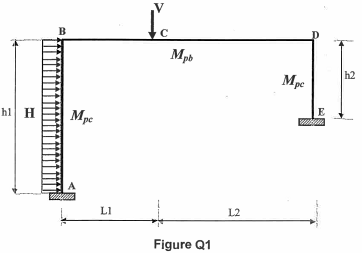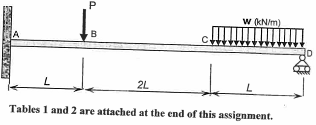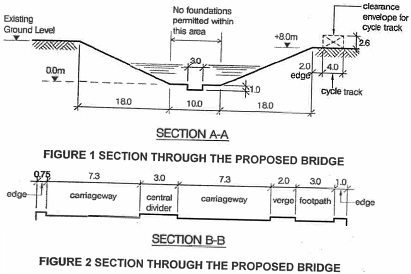Reference no: EM13972374
Aim:
1. To develop a student's ability to carry out plastic analysis of statically indeterminate beams and frames, to differentiate between different types of collapse mechanisms and to find the critical collapse mechanism and associated plastic moment.
2. To carry out open-ended design, followed by detailed steelwork design of a Welded Plate Girder (WPG).
3. To improve understanding of the structural behaviour of structural models.
Outcomes
• Apply quantitative methods and computer software relevant to the engineering discipline, in order to solve engineering problems
• Application of plastic analysis methods for the analysis of statically indeterminate beams and fames
• Understand appropriate codes of practice and industry standards Ment weighting
Part A: Plastic Analysis of Frames & Beams
Part B: WPG Design
Part C: Structural Behaviour
PART A: PLASTIC ANALYSIS OF INDETERMINATE BEAMS AND FRAMES
QUESTION 1
Figure Q1 shows a frame ABCDE which is fixed at supports A and E. The frame is subjected to a vertical load V at position C, and a horizontal total uniform load, H, on column AB.
For parts (a) and (b), the plastic moments for the beam (Mpb), and columns (Mpe) are shown against your name In the attached Table 1.
For the loading shown, investigate the following collapse mechanisms:
a) Sway Collapse Mechanism
Find the value of the total horizontal force H to produce the plastic moment in columns.
b) Beam mechanism
Find the value of the vertical force V to produce the plastic moment in
The beam.
c) Combined (Beam + Sway) Collapse Mechanism
(i) For the values of plastic moments Mpb and Mpc shown against your name in Table 1, find the mathematical relationship between the vertical force, V (kN), and the total horizontal force, H (kN), to produce the combined collapse mechanism.
Draw the interaction diagram which shows the relationship between the vertical force, V, and the horizontal force, H.
The horizontal axis of the diagram should show the values of the horizontal force H. The vertical axis of the diagram shows the values of the vertical force V.
(ii) Discuss the interaction diagram, and comment on the values of H and V which will cause the probable combined collapse mechanism.
(iii) Draw the corresponding bending moment diagram for the combined collapse mechanism for the following data:
h1 = 5m, h2 = 3m, L1 = 4m, and L2 = 2m.
H = 200 kN, V = 250 kN, Mpc = 122 kN.m, and Mpb = 244 kN.m

QUESTION 2
Propped Cantilever with a point load and partial uniform load.
The values of P, w, and L are shown against your name in the attached Table 2.
(a) For the beam shown in Figure Q2, there are FOUR possible collapse mechanisms. Investigate the FOUR possible collapse mechanisms, and find the value of the plastic moment capacity for each collapse mechanism.
(b) State the critical collapse mechanism from the results of Part (a).
(c) Draw the BMD for the critical collapse mechanism obtained in Part (a).
(d) Does the BMD satisfy the yielding condition?
(e) What is the minimum plastic modulus required for the beam section to resist the critical plastic moment obtained in Part (a)?
Assume the steel grade for the beam section is S275.

Part B: Welded Plate Girder Design
Introduction
This assignment is based in part on Question 3 of the IStructE Chartered Membership examination paper, April 2008. A new road bridge needs to be designed to span over a drainage channel and cycle track. The assignment is to be carried out individually and involves preliminary design, construction, precedence studies, hand drawing and the carrying out of manual structural calculations. The assignment gives students the chance to carry out some detailed steelwork design similar to that carried out by practising engineers.
Weighting
Three pieces of coursework account for 50% of the marks for the module. This assignment carries 20% of the marks for the module.
Objectives
Your submission must demonstrate:
1. Technical skill in the correct application of EC3 clauses in the design of a steel plate girder
2. Engineering judgement in the overall design of the bridge including its construction
3. Communication skills in the presentation of the structural calculations, the precedence studies and the drawings
4. Management of the design process (keeping to deadlines, ensuring that the submission is balanced and attends to each point in the brief).
The marking of the assignment will take into account the above objectives.
Design information
Client's requirements
1. A new road bridge is required to carry a dual carriageway and footpath over an existing storm-water drainage channel and cycle track.
2. No temporary or permanent works may be placed in the drainage channel within the central zone 10.0m wide.
3. The cycle track must be kept open at all times except from midnight to 5.00 a.m. A clear headroom of at least 2.6m over the cycle track is required throughout construction and on completion of the new bridge.
4. Approach ramps should be kept to a minimum height with a maximum gradient of 1:12.
Loading
1. Allowance for an "all in" permanent load of 9 kN/m2
This allows for the reinforced concrete deck of the bridge together with all surfacing, paving etc.
2. Vertical traffic variable loading 10.0 kN/m2
3. Footpath variable loading 5.0 kN/m2
Omit from consideration
1. Consideration of horizontal loading
2. Design of vehicle containment parapets on the bridge and bridge joints
3. Detailed design of foundations and supports for the plate girders
Assumptions
1. The steel plate girders do not act compositely with the reinforced concrete deck
2. Steelwork is to be designed in accordance with EC3. Design loads are to be factored in accordance with EC3 (no need to reference the new Eurocodes for bridge design)
3. Each span of the welded plate girder bridge can be designed as simply supported
4. Stiff bearing length of each plate girder at its support is 100mm
5. The top flange of each plate girder is laterally restrained by the RC bridge deck
Brief
1. Carry out a limited precedence study into welded plate girders in similar situations. Evidence of having actually seen the bridges in question (as opposed to simply Googling them) will be taken into account during marking. Seeing something with your own eyes is much better than seeing it on a computer screen. Some photographs, locations details (such as span, load etc.) and brief, insightful comments is all that is required here. Please take care when looking at a bridge and be aware of the hazards at the site.
2. Prepare a design for your bridge (positioning foundations but not designing them); choosing the spacing of the plate girders. Indicate clearly the functional framing, load transfer and stability aspects of your scheme. Prepare annotated, hand drawn plans, sections and elevations to show the dimensions, layout and disposition of the structural elements. This should be submitted using A4 size paper (20%).
3. Prepare structural calculations for the welded plate girder with the greatest span in your design. The calculations must cover the preliminary and detailed design of the main elements of the girder, deflection, web shear buckling, flange to web welds and finally, stiffener design at one of the supports/bearing.
4. Hand-draw a full length elevation of the welded plate girder, showing the sizes of the main elements. Include any necessary sections to make sure that you communicate your design fully. This should be submitted using A4 size paper.
5. Prepare a method statement for the safe construction of the bridge. This should be no more than a single side of A4 paper. This part of the assignment is directly related to Part 2. Your initial scheme must consider how the bridge will be constructed in a safe manner. Consider how you can approach safety using ERIC (eliminate, reduce, inform and control) as part of your risk assessment of the design.

Part C: Understanding structural behaviour
Introduction to the assignment and PeerWise
This assignment is designed to allow you to practise your structural analysis skills prior to the end of semester examination. All engineers working with structures need an understanding of how structures behave and being able to draw and interpret bending moment diagrams (BMDs) and shear force diagrams (SFDs) is an important part of this; as is an understanding of deflected shapes. Additionally, having a grasp of the development of tension and compression forces in triangulated structures is important. Together, these aspects comprise a small but crucial part of an engineer's understanding of structures.
PeerWise is an online resource that allows students to create multiple choice questions (MCQs) and to answer each other's questions. By providing helpful explanations with their MCQs, students demonstrate their understanding of the subject and their communications skills. Among many other things, students can rate each other's' questions and make comments also.
Weighting
Three pieces of coursework account for 50% of the marks for the module. This assignment carries 5% of the marks for the module.
Tasks
You are required to set a minimum of 4 questions (these should range in difficulty) and to attempt to answer a minimum of 25 questions. Your questions must include clear and concise wording, precise, neat and clear sketches, together with feasible options as answers to distract. Good, explanatory feedback must be provided with your questions to help students to improve their understanding and to learn from their mistakes.
• You must have set 2 questions by 5.00pm Monday 7 March 2016.
• You must have set a total of 4 questions (including the first 2) by 5.00pm Monday 4 April 2016.
• You must have answered a minimum of 25 questions by 5.00pm Monday 4 April 2016.
You will be able to continue to make use of PeerWise until the end of the semester as a revision aid; however your marks will be based on your submissions within the assignment period.
The marks for this part of the assignment are to be given as follows:
2 marks will be awarded, once the minimum requirements of questions submission and answering are met. Please note that the above deadlines must be strictly adhered to by all students.
3 additional marks will be awarded to those students with the highest reputation scores. Between 0 and 3 additional marks will be awarded to those students with lower reputation scores.
Question and PeerWise information
Here is a guide for students from PeerWise
https://peerwise.cs.auckland.ac. nz/docs/students/
Here is the general help page for anyone using PeerWise https://peerwise. cs. auckla nd. ac. nz/docs/
PeerWise is a simple system that you should find pretty intuitive to use. When setting questions it is important to be clear on the purpose of your question. What exactly will the question focus on? Using 'tags' or 'topics' will allow you to give other students a little basic information about your question and here are some suggestions.
| Table of suggested descriptive tags for questions |
| 1 Statical determinacy |
Statically determinate
|
Statically indeterminate |
| 2 Type of structure |
Beam
|
Cantilever |
Frame |
Triangulated
structure
|
| 3 Type of structural understanding |
| BMD |
SFD
|
Deflected shape |
Matching BMD and SFD |
|
Member forces
|
|
|
|
| 4 With or without numbers |
| Qualitative - without numbers |
Quantitative - with numbers |
Joining PeerWise
This will be explained in class, however, for the record: go to the PeerWise home page httos://peerwise.cs.auckland.ac.nz/
Select the school 'University of Bolton'
Then register by giving your own name, your own password, the course ID '12440', your identifier. Your identifier is your student number. Your student number is either a six or seven digit number with no dashes or slashes etc. By the way, it is recommended that you give a valid email address as this will allow you to reset your password should you ever forget this. This should now give you access to the course: CIE6001 2015-16 S2 Structural Behaviour.
You can now start to set and answer questions on PeerWise. If you are having difficulty gaining access to the course, please get in touch with your tutor Mike Bather.
Attachment:- Table data.pdf